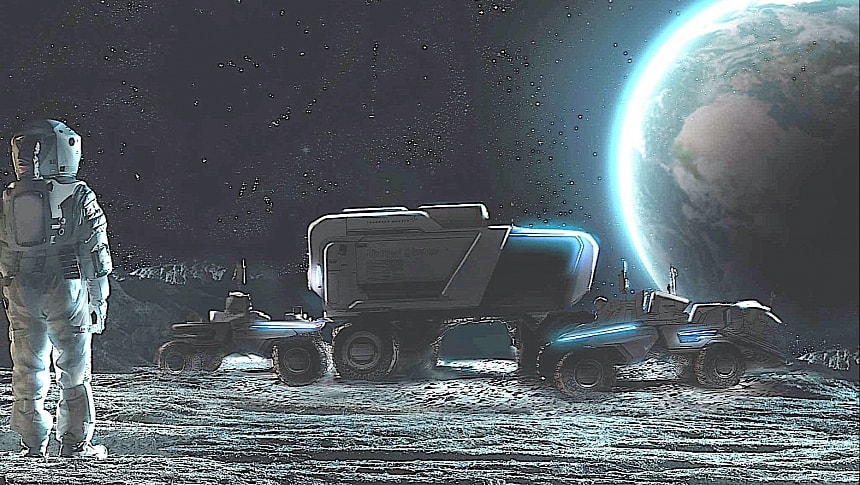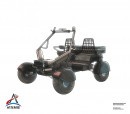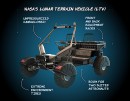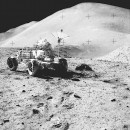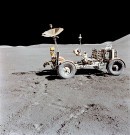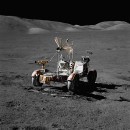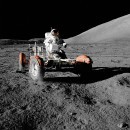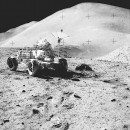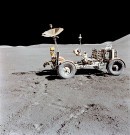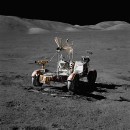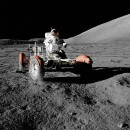The crew-carrying Artemis missions to the Moon are expected to start next year with the second flight of the program, the one that will not actually land humans on the Moon. The following year, Artemis III will do just that, followed in 2028 by Artemis IV. The people flying on these missions will move around the lunar surface on foot. But not the astronauts of Artemis V.
At the time of writing the Artemis V mission is scheduled to depart our world sometime in 2029, and it will be the first to use a new kind of lunar surface vehicle. Called Lunar Terrain Vehicle (LTV), it will be a kind of unpressurized Moon SUV that will be capable of taking astronauts to much further targets of interest than they could on foot.
This would not be the first time astronauts have used a wheeled vehicle on the surface of the Moon. During the Apollo program, Americans traveled the surface of the satellite on board something called a Lunar Roving Vehicle (LRV). It was a machine built by Boeing that took Apollo people to distances of 4.7 miles (7.6 km) around the landing site.
The LTV is expected to be much more capable than that, but also a lot more complex. That's why the companies that entered the NASA competition for the contract teamed up in groups and have been working on their proposals for roughly four years now.
What NASA is asking is simple on paper, but potentially hard to do in real life. The vehicle has to be able to withstand the harsh temperatures the Moon usually records - from 280 to minus 280 degrees Fahrenheit (138 to minus 173 degrees Celsius).
It will have to be able to carry a crew of two people, both of them wearing their astronaut suits, but also as much as 500 kg (1,100 pounds) of cargo, astronauts included.
The crew-rated rover will have to be electrically powered, will feature two equipment racks, one for each end of the vehicle, and will need to have headlights to make the terrain visible during lunar nights and in permanently shadowed regions of the Moon.
The LTV will also be equipped with a navigation console to allow astronauts to orient themselves, communications equipment, and a series of mandatory sensors and cameras. The sensors and cameras will need to be installed because the rover will also be autonomous.
This autonomous part thing is a bit of info NASA didn't really detail until this week, when it announced the names of the companies that will enter an advanced stage of design for the LTV.
We don't have all the details on what that means exactly, but NASA says the rover will have to be able to drive itself both when astronauts are on board and when crews are not on the surface of the Moon.
That's because the space agency plans to use the rover for scientific missions between Artemis flights as well. Also, because the rovers will not be owned by NASA, but will arrive there as a service from industry, the vehicle's makers will have the opportunity to use the machines for their own goals as well, unrelated to NASA's research.
A large number of companies and other kind of organizations competed for the contract (including, believe it or not, NASCAR), but only three of them were selected by the space agency. And their names are Lunar Outpost, Intuitive Machines, and Venturi Astrolab.
Lunar Outpost is a sort of aerospace powerhouse, as the research group it runs includes Lockheed Martin, General Motors, The Goodyear Tire and Rubber Company, and MDA Space. Their vehicle is called Lunar Dawn LTV.
Intuitive Machines is an older NASA partner and it recently made the headlines for becoming the first private American company to put a lander on the surface of the Moon - the Odysseus. It too works with big names of the aerospace industry, including Boeing and Northrop Grumman, but also with AVL and Michelin. The vehicle these companies are working on is called RACER – which stands for Reusable Autonomous Crewed Exploration Rover.
Last but not least comes Venturi Astrolab, a space startup that surrounded itself with a bunch of other space startups like Axiom Space and Odyssey Space Research to create something they collectively call the FLEX.
The fact that NASA chose these three teams doesn't mean all three of them will be part of the Artemis program. Each group now has a year to develop a system that meets NASA's requirements. After that, a subsequent request for task order proposal will be granted to the one that makes the cut.
At this point, the selected companies will have to conduct a real-life demonstration of the vehicle on the surface of the Moon. NASA says it expects only one provider to be selected for the demonstration.
The contract announced this week is huge in size, with a combined maximum potential value of $4.6 billion, split more or less equally between the participants. Once selected, NASA has plans to use the LTV through 2039.
Now that we know who's in the final leg of the race, we'll discuss each of the three proposed rovers throughout the day, in separate stories, so keep close.
This would not be the first time astronauts have used a wheeled vehicle on the surface of the Moon. During the Apollo program, Americans traveled the surface of the satellite on board something called a Lunar Roving Vehicle (LRV). It was a machine built by Boeing that took Apollo people to distances of 4.7 miles (7.6 km) around the landing site.
The LTV is expected to be much more capable than that, but also a lot more complex. That's why the companies that entered the NASA competition for the contract teamed up in groups and have been working on their proposals for roughly four years now.
What NASA is asking is simple on paper, but potentially hard to do in real life. The vehicle has to be able to withstand the harsh temperatures the Moon usually records - from 280 to minus 280 degrees Fahrenheit (138 to minus 173 degrees Celsius).
It will have to be able to carry a crew of two people, both of them wearing their astronaut suits, but also as much as 500 kg (1,100 pounds) of cargo, astronauts included.
The crew-rated rover will have to be electrically powered, will feature two equipment racks, one for each end of the vehicle, and will need to have headlights to make the terrain visible during lunar nights and in permanently shadowed regions of the Moon.
This autonomous part thing is a bit of info NASA didn't really detail until this week, when it announced the names of the companies that will enter an advanced stage of design for the LTV.
We don't have all the details on what that means exactly, but NASA says the rover will have to be able to drive itself both when astronauts are on board and when crews are not on the surface of the Moon.
That's because the space agency plans to use the rover for scientific missions between Artemis flights as well. Also, because the rovers will not be owned by NASA, but will arrive there as a service from industry, the vehicle's makers will have the opportunity to use the machines for their own goals as well, unrelated to NASA's research.
A large number of companies and other kind of organizations competed for the contract (including, believe it or not, NASCAR), but only three of them were selected by the space agency. And their names are Lunar Outpost, Intuitive Machines, and Venturi Astrolab.
Lunar Outpost is a sort of aerospace powerhouse, as the research group it runs includes Lockheed Martin, General Motors, The Goodyear Tire and Rubber Company, and MDA Space. Their vehicle is called Lunar Dawn LTV.
Last but not least comes Venturi Astrolab, a space startup that surrounded itself with a bunch of other space startups like Axiom Space and Odyssey Space Research to create something they collectively call the FLEX.
The fact that NASA chose these three teams doesn't mean all three of them will be part of the Artemis program. Each group now has a year to develop a system that meets NASA's requirements. After that, a subsequent request for task order proposal will be granted to the one that makes the cut.
At this point, the selected companies will have to conduct a real-life demonstration of the vehicle on the surface of the Moon. NASA says it expects only one provider to be selected for the demonstration.
The contract announced this week is huge in size, with a combined maximum potential value of $4.6 billion, split more or less equally between the participants. Once selected, NASA has plans to use the LTV through 2039.
Now that we know who's in the final leg of the race, we'll discuss each of the three proposed rovers throughout the day, in separate stories, so keep close.
